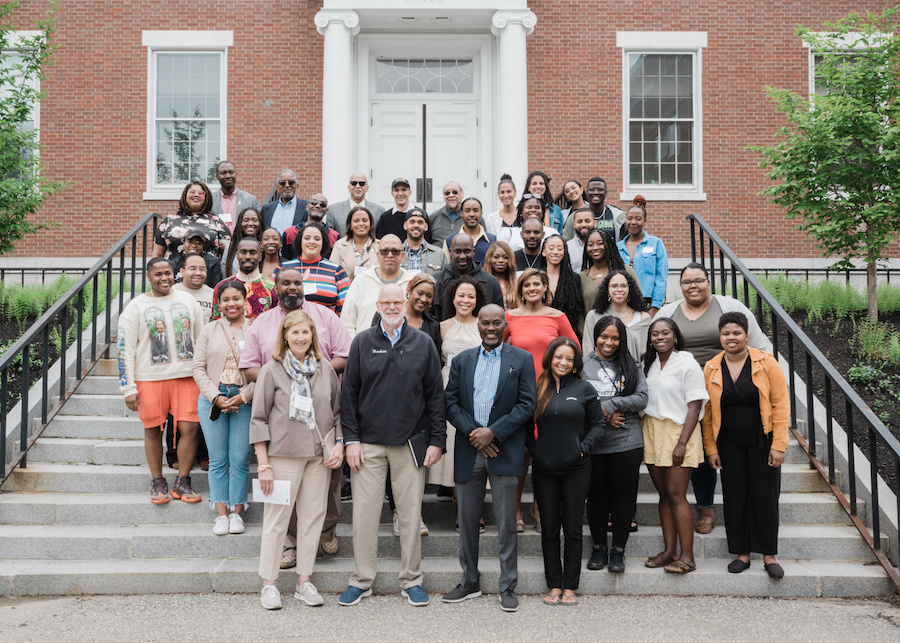Members of the BCBAA create community between Black alumni and students on campus
April 21, 2023
 Courtesy of Tristan Spinski
Courtesy of Tristan SpinskiWhen Adriennie Hatten ’90 returned to Bowdoin for a visit in 2018, she was surprised to discover how few of the Black students she spoke to had visited the John Brown Russwurm African American Center. When Hatten attended the College, she recalls, the center was where many of the Black students and faculty members at the College could be found at any given moment.
Now, she observes that the center feels to have lost some of its significance for Black students on campus.
The feeling that engagement and community has diminished for Black students at the College is not confined to dwindling student presence at the Russwurm Center. In response, a group of Bowdoin alumni from across the years began an effort to bring back to campus the community they hoped to see for Black students at the College. In December 2021, the group created the Bowdoin College Black Alumni Association (BCBAA).
The BCBAA’s mission is to revive the kind of community Hatten feels has been lost since her time as a student and to strengthen Black alumni engagement, which is low in comparison to white alumni engagement. To meet these goals, the BCBAA has instated a mentorship program and a diversity, equity and inclusion (DEI) committee among other initiatives.
Hatten believes the community for Black students has weakened since her time at Bowdoin. When Hatten arrived in 1986, there were only 13 Black students on campus, which she believes motivated the College to provide a more close-knit community and housing for most students in Russwurm. Now, Russwurm houses only four students from the African American Society and serves primarily as a location for events rather than as a consistent social hub for Black students.
“That’s where we had our parties, where we watched television … where we cooked our holiday meals when we didn’t go home for break,” Hatten said.
The change Hatten observed in the Black community at Bowdoin may be due, in part, to the expansion of the number of affinity groups for Black students and the creation of many other identity-based groups. Whereas there used to be one affinity group for Black students—the African American Society—the College is now home to the Black Student Union (BSU), the Africa Alliance and the Student Organization for Caribbean Awareness.
Heldana Daniel ’23, a student representative to the BCBBAA, said that the growing number of affinity groups and other clubs on campus has led to the community becoming more dispersed. During Black History Month, Daniel said, the three groups had to secure funding separately from the Student Activities Funding Committee (SAFC) to throw events. This competition resulted in fewer events, less funding and lower turnout across all three groups.
“Now we are trying to make their case against 1000 other clubs and activities, not only affinity groups … and we have to defend why we want $100 to throw an event,” Daniel said. “The way that alumni are explaining it is that the African American Society (now the BSU) had a set budget. Now it’s a lot more difficult because the Black affinity groups have to fight SAFC for basic funding to do anything, essentially.”
To reinstate these elements of community and to facilitate intergenerational community for Black Bowdoin students, the BCBAA started a mentorship program at the beginning of 2023 which pairs alumni with current students. Kevin Fleshman ’23, a student representative to the BCBAA, said that the mentorship committee was a popular idea among students hoping to meet alumni with shared career interests.
“I think students want valuable advice because our time is being pulled in so many different directions,” Fleshman said. “So say a student is interested in a mentor, I feel like the mentor should be someone that fits their specific interests.”
Members of the BCBAA, including Terri Young ’81, hoped that the mentorship program could provide a sense of connection with Black alumni that they felt was lacking when they were students.
“Mentorship and allyship and sponsorship is so important and something that back in the ’70s, when I went to Bowdoin, wasn’t necessarily there, especially not for African American students who were looking to find other African Americans who might be in fields of study they were looking toward,” Young said.
Mamadou Diaw ’20, a member of the BCBAA communications committee, was excited to see how many relationships took root between Black students and Black alumni at homecoming, where BCBAA members reunited and hosted events with current students.
“What was really great and insightful for me were … the connections that just organically happened, just from email transfers and actually getting people’s business cards,” Diaw said. “I feel like that is something that is really nerve wracking with networking–getting someone’s information and whatnot—but I felt like this was a very low-stakes show.”
The mentorship program is one of a number of BCBAA initiatives to strengthen the Black community at Bowdoin. Hatten hopes that the BCBAA will also work to make the increasing diversity of the college coincide with more inclusivity and equity.
“I feel like we’re more diverse but I’m not sensing that Black students actually feel that it’s a more inclusive space or that they’ve addressed some of the inequities that exist when you are a ‘minority population’ at a predominantly white institution,” Hatten said.

Comments
Before submitting a comment, please review our comment policy. Some key points from the policy: